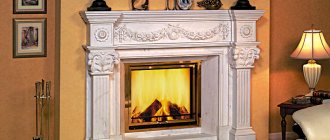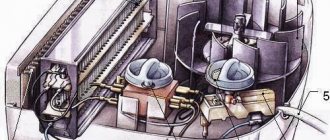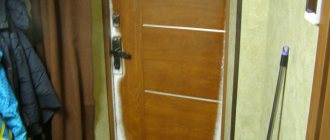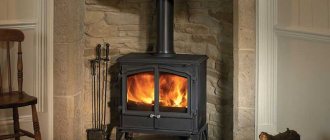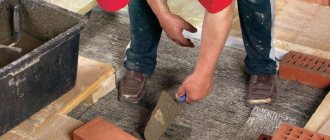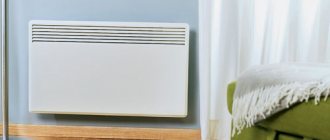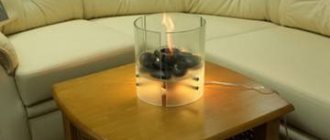Cast iron firebox with glass
A fireplace is a symbol of home and comfort. For a country house and cottage, this is also a way to heat the house, so in this article we will talk about how to choose the right inserts for cast iron fireplaces with glass and install them yourself.
Having decided to install a fireplace in their dacha, people wonder which firebox to choose. Today you can find many options on the market and each of them has its pros and cons.
One of the main parts on which the effectiveness of a fireplace depends is the firebox. It is the “heart” of the fireplace where fuel is burned. The duration of operation of the fireplace and its performance depend on the material, design and successful installation of the firebox.
Fireplace in the country
Types of fireplace inserts
Before considering the type of firebox, let's remember that the design of a fireplace includes 3 main elements:
- chimney;
- outer facing part;
- firebox
Basic elements of a fireplace
There are two types of fireboxes: open and closed.
The first option is more cozy and romantic. It’s so nice to sit in front of an open fire on a cold evening, admiring how the logs burn in the fireplace. But this design has a number of disadvantages:
- Insecurity. You cannot leave such a fireplace unattended.
- Inefficiency. Approximately 15% of the heat remains in the room. The rest evaporates through the chimney.
Therefore, the open-type design can be safely called decorative luxury, which allows you to create an atmosphere of warmth and comfort in the house. In addition, it will not be possible to regulate the fuel combustion power in such a fireplace. The only way of adjustment is a view, which allows you to open or close the damper in the chimney by controlling the draft. Such a design will not be used effectively as a heating system.
Open firebox type
But a closed fireplace is much more efficient to use for heating a country house in cold winter or in the off-season. It will not only perform a decorative function, being the main decoration of the living room, but also provide effective heating of the room.
Stylish fireplace with closed firebox
The efficiency and high performance of a fireplace with a closed firebox is due to a completely different operating principle compared to an open design. Heat accumulates inside the firebox and does not come out with combustion products. Thanks to this, a high efficiency is achieved. With a properly installed fireplace, the efficiency reaches 90-92%.
In addition, modern manufacturers equip closed fireboxes with a long-burning system (wood smoldering system), thanks to which the heat can be maintained for up to 12-15 hours after one filling. This is not only effective, but also very economical. You can adjust the degree of oxygen supply, which affects the intensity of combustion, using the knob.
Closed fireplace
With such a heating system, you can calmly go to bed, and the fireplace will slowly release heat. The next morning, the house will have a good temperature and atmosphere.
The advantages of a closed firebox include:
- High performance (up to 92% efficiency).
- Residual combustion products (ash and ash) are collected in a special ash pan, which guarantees cleanliness in the house.
- High fire safety. There is no chance of sparks hitting the flooring or furniture.
- Long service life.
- Fuel efficiency.
- The fireplace can operate automatically without the constant presence of a person and control of the flame.
- Possibility of adjusting combustion intensity.
The disadvantages of a closed type of firebox include narrow glass in budget versions, which makes it impossible to admire the open flame.
Closed cast iron firebox
It should be noted that a closed type of fireplace can be made from an open structure. To do this, it is necessary to insert a closed cast-iron firebox into the overall structure of the fireplace. The firebox itself is a fireplace insert (cassette), which is closed with a glass door.
This liner is connected to the chimney, from where combustion products are then removed.
Plasterboard cladding
It is not necessary to buy fireproof boards; you can also use moisture-resistant material. Cutting drywall parts is done using a simple paint knife. A cut is made along the marked line under any straight plank, after which the canvas is bent. The cardboard on the other side is trimmed.
When making a functional fireplace, the firebox and smoke exhaust box must be installed with thermal insulation and a foil reflector inside the device.
Do-it-yourself lining of a fireplace insert with plasterboard can cause difficulties in hard-to-reach places. And so the assembly technology is no different from any other gypsum board construction:
- The sheets are sewn to the profiles using metal screws. The hats go deeper into the canvas. It is better if individual parts are cut from a single sheet. This will make pre-finishing much easier. To process the corner joints of the structure, use a special plasterboard plane or a painting knife.
- For thermal insulation on the inside, the cladding is made using a basalt slab and foil. There is foil mineral wool. But attention should be paid to the quality of the glue used in this material. It must meet safety standards and withstand prolonged exposure to elevated temperatures.
The smoke exhaust box can also be made of plasterboard. Thermal insulation and foil reflector should be installed inside the device. The chimney box has holes for ventilation grilles.
Advantages and disadvantages of a cast iron firebox
Now that we have decided on the type of fireplace design, we need to choose the material for the firebox. The firebox can be lined with fireclay bricks or made of cast iron or steel. Unlike steel structures, cast iron fireboxes are inexpensive and practical.
Cast iron fireplace in the country
The advantages of such cast iron fireboxes include:
- fire resistance;
- resistance to deformation;
- ease of installation;
- low price;
- high performance;
- good thermal conductivity;
- excellent chamber sealing;
- the ability to warm up a room of up to 300 square meters;
- high heat storage capacity.
The special design of the cast iron closed firebox with glass allows you to accumulate thermal energy and release up to 70% into the room.
The outer part of such a firebox is covered with a special protective paint that can withstand high temperatures of up to 700-700 degrees Celsius. The front side is equipped with a glass door, which allows you to monitor the intensity of the flame, admire the hearth and add firewood.
Cast iron firebox
And the lower part of any combustion chamber requires the presence of an ash pan. This is the place where combustion products accumulate: resins, ash, ash. This part of the fireplace also performs another function. As you know, the combustion process cannot occur without oxygen. It is through the ash pan that air enters the cast iron combustion chamber.
The disadvantages of cast iron fireboxes with glass include:
- small view of the viewing window;
- the window quickly becomes covered with soot, which further reduces the view;
- All products are produced in black, which does not allow you to vary the design of such a fireplace.
But the last point can be easily corrected if you install a decorative grille on the fireplace in the form of a bronze openwork mesh.
Installation Rules
The rules for installing any fireplace require choosing a good location. For example, an essential detail for corner options is the presence of a quarter meter indentation from the fireplace wall. This space should be left for free circulation of oxygen. Although you will need quite a lot of space, installing this particular type of fireplace will significantly improve heat exchange.
The rules require an accurate calculation of the dimensions of the furnace unit. The heating part must correspond to the heat losses of the room.
In most options, the calculations assumed by SNiP must take into account:
- number of window openings;
- type of glazing;
- characteristics of the insulation used;
- number of storeys of the building;
- thickness and material of the walls.
The installation rules assume that one stove is used to heat a room no larger than 40 square meters. m. You should not expect to heat 100 square meters with one fireplace. m in a townhouse. The option with one fireplace on several floors is also undesirable. In this case, it is impossible to ensure uniform heating, since warm air rises. It is better to build different fireplaces on several floors, albeit smaller ones.
A significantly reduced size of the fireplace in relation to the dimensions of the room will lead to large temperature fluctuations in the room. A greatly increased size of the fireplace will lead to stuffiness in the rooms, as well as to excessive consumption of firewood.
The rules for choosing the size of a stove for a specific room require precise manipulation of numbers and indicators. The heat loss of the room is calculated from the heat loss of one cubic meter of room - 21 kcal/hour. For calculations, it is enough to multiply the external dimensions of the room by 21. For example, in a wooden house these indicators can be 5.5 meters wide, 6.5 meters long and 3 meters high. The conditional volume of heat losses is 107.25*21=2252.25 kcal/hour.
It is known that 1 cu. m of fireplace produces an average of 300 kcal/hour. This means that the heat loss of the room must be divided by 300. 2252.25/300 = 7.5075 cubic meters. m. The permissible height of the fireplace in the room is up to 2 meters. If you divide 7.5 by 2, you get a stove area of 3.75 square meters. m.
The optimal dimensions of the heating device will allow you to retain heat in the room with a one-time daily heating. If the fireplace insert is purchased, as a rule, the heat output is indicated in the standard design. The pipe cross-section is selected in accordance with the power of the furnace. If there is a purchased design, all the components of the fireplace are selected in accordance with the dimensions of the device.
How to choose the right firebox?
Having decided on the type of design and material for making the firebox, all that remains is to choose a model. What parameters should you use to choose a cast iron firebox, given that the market today offers many different models and manufacturers?
- Furnace power.
This is perhaps the main parameter on which the efficiency of the fireplace will directly depend. In order to choose a fireplace that will actually heat the room, and not just perform a decorative function, you should correctly calculate the area of the room. The furnace power we need will depend on this parameter.
The power of the firebox depends on the area of the room
Also, the power of the firebox determines its weight, diameter and length of the chimney.
We calculate the total area of the room using the standard formula:
We measure the length and width of the room in meters, multiply the results. Now that you know the square footage of the room, you can determine the required furnace power.
We measure the area of the room
Important! Consider not only the total area of the room, but also the number of windows, their width, and the presence of doorways. All this will increase power requirements.
We take into account the number and width of window openings
For a room area of 50-100 m2, the furnace power should be at least 10-12 kW.
For a room over 100 m2, choose a firebox power of at least 15 kW.
- Door material. The door is one of the most important parts of the firebox. In order for the door to withstand high temperatures of 750-8000 C, it is made from quartz heat-resistant glass or ceramic crystal.
Attention! Fireplaces with transparent glass doors are made of refractory ceramics. But models with cloudy yellowish glass are made from quartz heat-resistant glass.
The door is made of glass
Today on the market you can find budget models with a small glass door, but you can also buy more expensive fireboxes with double-leaf or curved glass doors. Of course, the difference is purely in decorative functions, because it is much more pleasant to admire the glow of the fire when the fireplace is equipped with a firebox with a large glass door. Improved fireboxes are equipped with doors with automatic window cleaning. Due to the supply of hot air, the glass is easy to clean from dust, soot and soot.
- Firebox shape: regular (front) and angular. Here the choice, of course, depends on the location of the fireplace. The front firebox, in turn, can have the shape of a trapezoid or rectangle.
Corner firebox
The advantage of a conventional front firebox is its affordable price and high performance. Due to the fact that the chimney is located next to the firebox, without unnecessary bends, the draft in such a fireplace will be better. But in a corner firebox, such productivity is reduced due to the remote location of the chimney pipe.
- Glass door shape: flat, circular or segmented. Of course, the most budget option would be to buy a firebox with a flat door. But if you want to add originality to your interior, then pay attention to stylish models with a circular spherical glass firebox.
Semicircular shape of the fireplace
You can also find a combined type of door, when one part is made of steel, decorated with decorative forged elements, and the view behind the fire is provided by the glass part. This style of stained glass will help add a special touch of comfort and antiquity to the interior.
- Price. The final price of the firebox is greatly influenced by the quality of the glass, so you need to be careful when choosing this product. It can be single-layer or multi-layer. It is also important to consider parameters such as service life and heat resistance. The product passport usually indicates the guaranteed operating time (indicated in hours). And the heat resistance of glass depends on its strength - a parameter specified in the technical data sheet in millimeters. The optimal glass thickness in terms of price and quality is 4 mm.
Design
This is the very first stage, during which several important points should be taken into account, especially for functional fireboxes:
- It is necessary to determine the location for the equipment in the room relative to the walls and furniture arrangement. At the same time, do not forget about fire safety: the distance from flammable surfaces to the firebox is at least 700 mm.
- The base for the equipment is recommended to be made of concrete with a height of 300 mm. The perimeter of the foundation should extend beyond the dimensions of the firebox by 250 - 300 mm on each side.
- The recommended gap between the firebox and the plasterboard structure is 50 mm.
- An air vent box should be provided.
- Podium. The design must provide air flow for heating and support the weight of the firebox.
- The thickness of the fireproof wall finishing and a technical gap of 100 mm between it and the firebox.
- To accurately determine the dimensions of the portal, you should take into account the parameters of the facing material: profiles: guide – 27×28 mm and rack – 27×60 mm). For cladding, it is recommended to use fireproof or moisture-resistant plasterboard with a thickness of 12.5 mm.
- The design of the portal and its decoration should fit organically into the interior.
The listed parameters will help you avoid installation errors.
Features of glass doors for cast iron fireboxes
As mentioned above, ordinary glass will not be suitable for installing a glass door in the combustion chamber. It must have a high heat-resistant index.
The main task of such glass is to protect the house from fire, because a fireplace always represents increased fire safety. No matter how beautiful and romantic the process of lighting a fireplace and admiring an open flame is, there is always a risk of fire from the slightest spark.
Glass door of cast iron firebox
Installing such glass in a cast iron firebox requires certain knowledge and skills.
The main difference between heat-resistant glass for fireboxes and ordinary tempered glass is the casting expansion when heated. It does not develop cracks or chips during use. When purchasing glass for a cast iron firebox, pay attention to its maximum temperature. A material of 600 degrees will withstand a long period of time, but if it is exposed to a temperature of 750-800 degrees, then such glass will not withstand even several hours.
The performance properties of glass for fireboxes are affected by the type of fuel. Each type of fuel has its own technical characteristics and maximum combustion temperature. This must be taken into account before purchasing and installing.
Glass door of cast iron firebox
To extend the life of the firebox glass, you must adhere to basic safety measures:
- Do not douse the flames with water in the fireplace. A sudden change in temperature can affect the technical characteristics of the glass.
- Do not use harsh abrasive substances when cleaning the door and combustion chamber. The scratch itself will not violate the technical characteristics of the glass, but soot will accumulate faster at the point where it occurs, obscuring the view.
- The service life is also affected by the correct installation of the door. If the draft in the fireplace is disrupted and the glass is constantly exposed to flame, then such a door will not last long, no matter how durable heat-resistant glass it is made of.
Attention! To ensure a beautiful aesthetic appearance of the glass door, you should monitor the quality of the firewood. If you use well-dried logs, the likelihood of soot formation will be minimized. If you throw foreign debris into the fireplace and use firewood with a high resin content, the door will be constantly covered with soot, ruining its beautiful appearance.
Finishing
For final cladding, the plasterboard base is prepared as follows:
- The screw caps are covered with putty. The composition should be selected for aggressive environments with elevated temperatures.
- After hardening, the excess is removed with a spatula or special masking paper/sandpaper.
- At the end, the surface is completely puttied, sanded, and primed. The plasterboard finish on the fireplace insert matched the finishing lining.
GCR is a universal material, so porcelain stoneware, gypsum, clinker tiles, natural stone and others can be used as a finishing coating. The finish is selected to match the style of the interior.
An interesting solution is porcelain stoneware. The modern market offers this tile with an imitation of any other finishing material - marble, granite, wood. Moreover, the canvases can also have a texture similar to natural fibers.
Finishing a fireplace with plasterboard with your own hands is a simple process, but it has a number of subtleties. False fireplaces do not require thermal insulation or a solid foundation. It’s enough to just build a plasterboard portal and choose the appropriate finish. In the case of functioning furnaces, it is recommended to contact professionals who will perform high-quality installation, which will ensure the reliability of the equipment and fire safety.
Features of installing a cast iron firebox
Of course, installing a fireplace and installing a firebox is a very tricky and tricky business. If you are not confident in your abilities and knowledge, then it is better to entrust this matter to professionals. After all, improper installation of the firebox can be fraught with serious problems, ranging from poor draft to the risk of fire.
If you are confident in your abilities and want to install a cast iron firebox with glass yourself, then we suggest you follow our detailed step-by-step instructions.
The finished design of a cast iron firebox can be purchased at the store, or it can be made in advance. The latter option requires serious skills and professional tools. Therefore, in this article we will dwell in detail on the installation and installation of a ready-made cast iron firebox design.
The installation option also depends on whether you are building the firebox into an already prepared fireplace structure with a chimney or building a fireplace from scratch. If you have decided to replace only the old firebox with a new cast-iron one with glass, and you have a fireplace portal, along with a system for removing combustion products, ready, then feel free to proceed to step 3.
We offer here detailed instructions on how to set up a fireplace with a cast-iron firebox from the very beginning.
Video. Step-by-step installation of a fireplace with a closed cast-iron firebox
Preparing the base
Considering that fireplaces are fire hazardous equipment, preparation of the floor and adjacent walls should be provided before covering the fireplace with fireproof plasterboard.
Floor preparation
The fireplace insert has a significant mass. Plus is equipment with an increased fire hazard. Therefore, at the first stage, a concrete base is prepared:
- The portal is marked on the floor.
- The formwork is being installed.
- The base is primed and filled with concrete.
- After hardening, a podium is laid out (4 rows of brickwork). Then install metal corners under the firebox.
- Lay the final level of masonry.
The whole process is carried out strictly according to the level. A misalignment of the foundation and podium will cause problems with the quality installation of the firebox.
Preparing the wall
The simplest option is when the adjacent wall is made of aerated concrete, foam concrete blocks or bricks. In this case, it is plastered and whitewashed. If the adjacent wall is made of flammable materials (logs, beams, etc.), then the following work is performed:
- Treating the wall with fire retardant compounds.
- Fastening a foil-coated basalt slab to a metal profile. A ventilation gap is required between the wall and the facing slab. The dimensions of the protective screen should be 500 - 600 mm larger than the dimensions of the future furnace.
- Fixing drywall, which is puttied, and clinker or porcelain tiles are laid on top.
DIY decorative fireplace made of plasterboard
Other options: asbestos board, magnesite. If the equipment will be installed in a corner, the joint between the walls is treated with a special fire-resistant sealant.
The same thermal insulation is also applied under the chimney. You should know that the gap from the fire-resistant wall to the rear surface of the firebox must be at least 100 mm, from the combustible surface - at least 700 mm.
Chimney pipe laying
After the installation of the main part of the fireplace is completely completed, it is necessary to begin the construction of the chimney pipe.
Important: depending on how quickly you want to complete all the construction work, you can make either the simplest chimney, which has standard straight outlines and shapes, or a more complex one (having a tendency to gradually narrow).
How to brick a fireplace, a step-by-step guide to assembling a tapered chimney:
- We calculate the optimal angle of inclination of the structure. The angle should not be more than 4-5 centimeters, this can lead to interruptions and improper operation of the traction mechanism;
- Each row should have the same angle of inclination;
- In order for heated air masses to escape and heat the room, at a height of 25-35 centimeters, you need to make several small holes that will act as ventilation;
Covering materials
Solid kiln bricks or refractory bricks are used. The second option is most relevant for burning coal. The brick must be uniformly colored and fired, and have no cracks or chips on the surface.
For the body of the fireplace, a clay-sand mortar is used, mixed in the following proportions:
- 1/1 - for normal clay;
- 1/2 - for oily clay.
Water 1/4, consistency of thick sour cream
For the foundation and in the case of lining the chimney from the roof to the cap - cement-sand, mixed in a ratio of 1/3.
Additional elements - metal corners, arched profile, anchors, and so on. As the design scheme is selected, the issue of choice of materials is decided.
